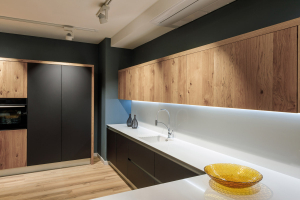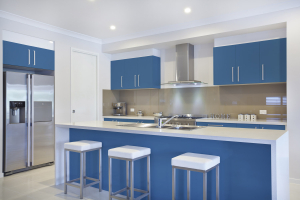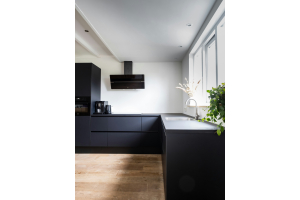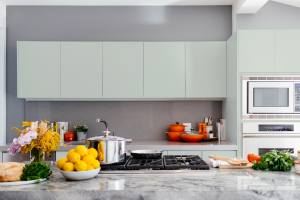Frameless cabinets have been increasing in popularity for years. What started as a uniquely European feature in kitchens has become the cabinetry of choice for many Americans looking for a more modern look. Frameless cabinets came about after World War II when manufacturers began using a standardized system revolving around thirty-two-millimeter gaps between pre-drilled holes used in holding up cabinet shelves as well as drawer and door hardware.
This standardization came about out of necessity, as much of Europe needed to be rebuilt in a hurry after the war and standardized parts meant simpler construction. You can still see this influence today in many forms of furniture that you purchase at the store and assemble yourself.
Despite their popularity and modern design, the debate between face-frame versus frameless cabinets continues.
Frameless Cabinet Pros
Larger Door Opening
Because there isn’t a frame around the edges of the cabinet front which partially blocks access to the cabinet interior, you can place larger items such as cutting boards into frameless cabinets much easier without having to manipulate them through the frame and into the cabinet.
More Interior Space While Taking up Less Square Footage
While not seen in many standard American homes, if you visit any large city with smaller apartments, you’ll often see frameless cabinets. This is because in small apartments, inches of space can matter a lot. Frameless cabinets eliminate the exterior frames that may cut into much-needed space between doorways and walls.
Hinge Mounts and Disconnects Are Easier to Work With
Because the hinges for frameless cabinets are attached to the interior sides of the cabinets, they are often more accessible. Many frameless cabinets also come with quick-disconnect hinges that pop out with quick-release tabs.
Seamless and Modern Look
Because of the ultra-thin gaps between frameless cabinets and drawers, the face of the cabinets often looks uniform and smooth. This leads to a contemporary look which is especially appealing for its unique style not often seen in American homes. When coupled with other kitchen dressing such as stainless steel appliances, frameless cabinets can give your kitchen a brand-new feeling that will last for years.
Cons of Frameless Cabinets
Inset Doors Are Not Available
Cabinet doors that are inset into the frame of the cabinet are not available as there is no frame to mount them on, which means your cabinet doors can only be overlaid on the outside of the door. This is only a negative from a personal aesthetics point of view, however, as the overlay design of frameless cabinetry actually allows more interior space than their framed counterparts.
Claims of Poor Quality Materials
Poor-quality frameless cabinets do exist, but only as a consequence of DIY cabinetry bought from big box stores and self-assembled without proper knowledge of how to screw frameless cabinets together. Proper frameless cabinetry built and installed by a professional will be stronger due to the additional thickness of interior walls required to hold all of the door and drawer hardware in place.
You Still Need Fillers
Even frameless cabinets can’t be entirely free of some form of frames here and there. You still need fillers for frameless cabinets. Corners, doorways, and countertop placement will all affect how much filler wood will be needed to provide a large enough gap to allow doors to fully open and close without crashing into other doors or walls.
In Summary
Generally speaking, frameless cabinetry is not more expensive. However, individual choices in material quality and who you choose as your installer can make a huge difference in costs. This can make either frameless or framed cabinets cheaper or more expensive when adjusting installers and material quality.






